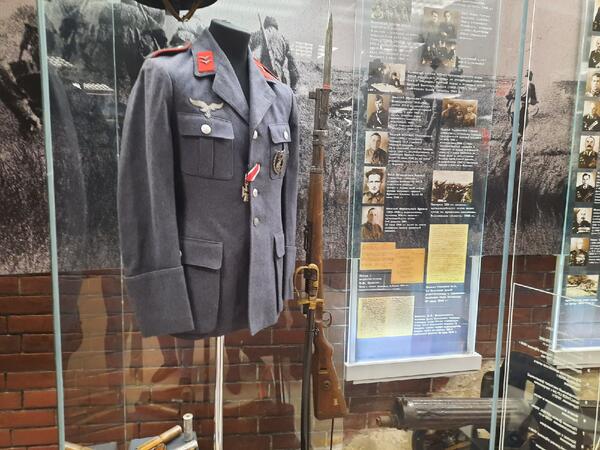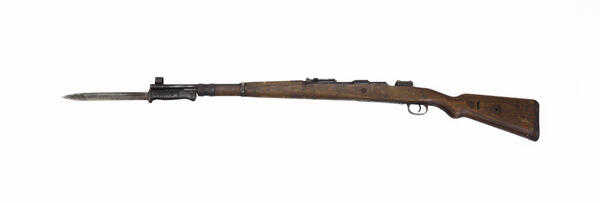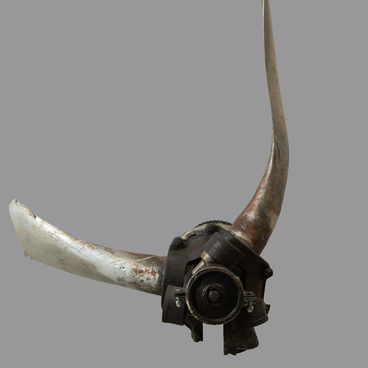In 1898, the brothers Wilhelm and Paul Mauser designed a rifle, which was in use for a long time. Millions such rifles were produced. The rifle received the designation Gew.98 and entered service with the German army on April 5, 1898.
Somewhat later, the Radfahrgewehr 98 carbine for bicycle infantry was developed based on the original Gew.98 model which was intended for cavalry units. The Kar.98 in its original form was produced only until 1905, when, due to the adoption of a new 7.92×57mm cartridge, which had a pointed bullet instead of a flat-tip one, the Gew.98 model underwent the first changes in its design.
In 1908, a new version of the carbine based on the Gew.98 appeared, which received the designation Kar.98a. In 1923, the K98b carbine was released. In fact, it was not technically a carbine, but rather a modification of the Gew.98 with simplified iron sights, a turned-down bolt handle and a stacking rod attached to the buttstock near the muzzle to stack the rifles easier.
In 1935, a new universal 7.92mm Karabiner 98 kurz (the Kar.98k or simply K98k) was accepted as a standard service rifle for all branches of the German Wehrmacht, replacing the Gew.98 rifles, as well as the 98a and 98b carbines. The barrel was shorter even compared to the 98a one. It had a turned-down at 90 degrees bolt handle, which was placed in a recess on the stock, and a side butt attachment point for a sling. These improvements in design made the carbine a fairly compact weapon that was convenient for various types of troops (infantry, cavalry, motorcyclists, gunners, sappers, and so on). The Mauser K98k carbines were equipped with standard SG 84/98 bayonets, significantly shorter and lighter than the bayonets provided for the Mauser 98 rifle. The SG 84/98 bayonet had a blade length of 25 cm with a total length of 38.5 cm. During the Second World War, bayonet fighting was extremely rare, so in order to save money, since the end of 1944, the rifles were no longer equipped with bayonets. They even lacked a bayonet mount or a ramrod. The 98k carbines were fitted with very short cleaning rods (there were standard ramrods with a length of 25 and 35 cm): to clean the bore, it was necessary to screw one ramrod onto another. Standard rifles were used as sniper rifles: the ones giving maximum accuracy were selected out of each batch.
The K98k was in service with more than 20 armies of the world and there were more than 14 million copies made. This weapon proved itself as one of the best. It was not the submachine gun, as previously thought, but rather the carbine that was the main weapon of the Wehrmacht.
Somewhat later, the Radfahrgewehr 98 carbine for bicycle infantry was developed based on the original Gew.98 model which was intended for cavalry units. The Kar.98 in its original form was produced only until 1905, when, due to the adoption of a new 7.92×57mm cartridge, which had a pointed bullet instead of a flat-tip one, the Gew.98 model underwent the first changes in its design.
In 1908, a new version of the carbine based on the Gew.98 appeared, which received the designation Kar.98a. In 1923, the K98b carbine was released. In fact, it was not technically a carbine, but rather a modification of the Gew.98 with simplified iron sights, a turned-down bolt handle and a stacking rod attached to the buttstock near the muzzle to stack the rifles easier.
In 1935, a new universal 7.92mm Karabiner 98 kurz (the Kar.98k or simply K98k) was accepted as a standard service rifle for all branches of the German Wehrmacht, replacing the Gew.98 rifles, as well as the 98a and 98b carbines. The barrel was shorter even compared to the 98a one. It had a turned-down at 90 degrees bolt handle, which was placed in a recess on the stock, and a side butt attachment point for a sling. These improvements in design made the carbine a fairly compact weapon that was convenient for various types of troops (infantry, cavalry, motorcyclists, gunners, sappers, and so on). The Mauser K98k carbines were equipped with standard SG 84/98 bayonets, significantly shorter and lighter than the bayonets provided for the Mauser 98 rifle. The SG 84/98 bayonet had a blade length of 25 cm with a total length of 38.5 cm. During the Second World War, bayonet fighting was extremely rare, so in order to save money, since the end of 1944, the rifles were no longer equipped with bayonets. They even lacked a bayonet mount or a ramrod. The 98k carbines were fitted with very short cleaning rods (there were standard ramrods with a length of 25 and 35 cm): to clean the bore, it was necessary to screw one ramrod onto another. Standard rifles were used as sniper rifles: the ones giving maximum accuracy were selected out of each batch.
The K98k was in service with more than 20 armies of the world and there were more than 14 million copies made. This weapon proved itself as one of the best. It was not the submachine gun, as previously thought, but rather the carbine that was the main weapon of the Wehrmacht.




